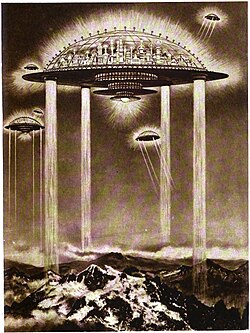Earth
In the treatise De Grandine et Tonitruis ("On Hail and Thunder", 815), Carolingian bishop Agobard of Lyon describes Magonia , a cloud realm populated by felonious aerial sailors. [2]
In the novel Gulliver's Travels (1726) by Jonathan Swift, the island city of Laputa was revealed to be floating in the sky. Laputa purportedly levitated through use of artificial magnetism. It was primarily a fictional device that was intended to satirize far-fetched pseudo-scientific proposals:
- I turned back and perceived a vast Opaque Body between me and the sun, moving forwards towards the island; it appeared to be about two Miles high, and hid the Sun six or seven minutes.[...] the Reader can hardly conceive my Astonishment, to behold an Island in the Air, inhabited by Men, who are able (as it should seem) to raise, or sink, or put into a Progressive Motion, as they pleased. [3]
During the 1920s, science fiction author Hugo Gernsback speculated about floating cities of the future, suggesting that 10,000 years hence "the city the size of New York will float several miles above the surface of the earth, where the air is cleaner and purer and free from disease carrying bacteria." To stay in the air, "four gigantic generators will shoot earthward electric rays which by reaction with the earth produce the force to keep the city aloft." [4]
In 1960, the architects Buckminster Fuller and Shoji Sadao proposed the construction of a 1-mile-diameter (1.6 km) thermal airship, which they called Cloud Nine. This megastructure would be a geodesic sphere that, once it was sufficiently heated by sunlight, would become airborne. [5] Fuller and Sadao envisioned that Cloud Nine would float freely in the Earth's atmosphere, giving residents and passengers a migratory lifestyle. They believed that it might be a partial solution to the depletion of non-renewable resources.
A team including Buckminster Fuller and Shoji Sadao [6] was commissioned by United States Department of Housing and Urban Development to design the Triton City, a floating city intended to provide housing near Tokyo or Baltimore. The proposal called for tetrahedron–shaped modules supporting large housing blocks of 5,000 inhabitants each, and which would be anchored to the ground. A large model of the habitat is on display in the lobby of the Johnson Presidential Library in Austin, Texas. [7]
In Isaac Asimov's story "Shah Guido G.", the hereditary Secretary-General of the United Nations ("Sekjen") is a tyrant who rules the Earth from a flying island called Atlantis.
Other planets
In addition to Venus, floating cities have been proposed in science fiction on several other planets. For example, floating cities might also permit settlement of the outer three gas giants, as the gas giants lack solid surfaces. Jupiter is not promising for habitation due to its high gravity, escape velocity and radiation, but the Solar System's other gas giants (Saturn, Uranus, and Neptune) may be more practical. In 1978, the British Interplanetary Society's Project Daedalus envisioned floating factories in the atmospheres of Jupiter refining helium-3 to produce fuel for an interstellar probe. Michael McCollum notes that the "surface" gravity of Saturn (that is, at the visible cloud layer, where the atmospheric pressure is about the same as Earth's) is very close to that of Earth, and in his novel The Clouds of Saturn, he envisioned cities floating in the Saturnian atmosphere, where the buoyancy is provided by envelopes of hydrogen heated by fusion reactors. Uranus and Neptune also have upper atmosphere gravities comparable to Earth's, and even lower escape velocities than Saturn. Cecelia Holland populated Jupiter, Saturn and Uranus with mutant humans, the Styth, in floating cities in her only SF novel, Floating Worlds (1975). Donald Moffitt's novel Jovian (2003) features floating cities forever floating in the Jovian atmosphere, a worthwhile enterprise due to their ability to extract useful gases. The book concentrates on the cultural differences (and political tensions) developing between "Jovian" humans and Earthbound ones.


